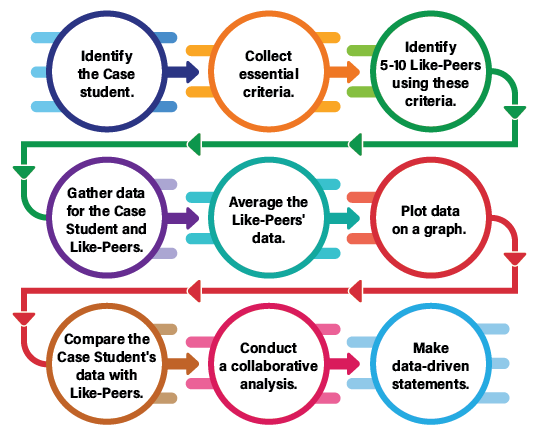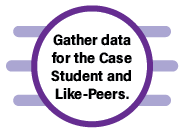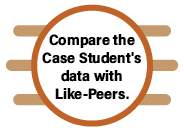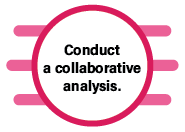You are here
Linguistically Responsive Data-Based Instructional Decision-Making for K-12 Multilingual Learners

On this page
Introduction
Educators, schools, and districts make important decisions about curriculum, programs, schedules, student placement, and interventions. When these decisions involve Multilingual Learners (MLs), it is essential to analyze existing data carefully, focusing on language proficiency and sociocultural factors that impact academic achievement.
Two key data sources should be considered together for MLs receiving instruction in English: English Language Proficiency (ELP) Assessments and Content-Area Assessments. When MLs take content-area tests in English, their ability to fully demonstrate their knowledge and skills is influenced by their English language proficiency. Because of this, academic achievement results for MLs cannot always be taken at face value; they require deeper analysis to make informed instructional decisions.
This is particularly true when determining eligibility for Special Education and the need for Specially Designed Instruction (SDI). Decisions about MLs in Special Education must be based on a comprehensive review of information from multiple data sources rather than relying on any single criterion [34 CFR § 300.304 (b)(1-2)].
A 2024 study by the Migration Policy Institute (MPI) highlights the strong link between English language proficiency (ELP) and academic performance. The study found that 28% to 53% of the variation in English Language Arts (ELA) and math scores could be explained by students’ ELP levels. This shows that a significant part of MLs’ performance on standardized state tests is influenced by how well they know and use English.
These findings underline the importance of critically analyzing data to address the unique needs of MLs. Adopting culturally and linguistically appropriate practices is crucial to ensuring effective decision-making for MLs.
Promising Practices:
-
Systems-Level Local Normative Data (LND) for MLs: Administrative units and districts can make more informed decisions by using local data that reflect their communities’ unique needs. This helps to better tailor professional development and programming for all student populations, including MLs.
-
Leveraging Like-Peer Comparative Data at the Student Level for MLs: School teams can use data comparing individual MLs (referred to as Case Students below) to their demographically similar peers to guide more culturally and linguistically responsive decisions about instruction, intervention, enrichment, and, when necessary, special education evaluations. Note: The CDE now uses “Like-Peer Comparative Data” to convey the same concept as “True Peer Comparative Data.”
By incorporating these data-gathering, disaggregating, and analyzing practices, educators can better support MLs' academic growth and promote equity in both instructional and evaluation processes.
Local Normative Data (LND) helps educators troubleshoot challenges by providing a deeper, community-contextualized understanding of a student’s strengths and needs. This ensures that instruction, interventions, enrichment, and supports are appropriate, culturally responsive, and tailored to each ML's individual needs.
LND enables comparisons between the characteristics or conditions of an individual or group and the average values of a reference population. These comparisons help identify deviations from what is typical within a specific context, offering actionable insights for targeted interventions and support (EuroQol Group, 2004; Ware & Keller, 1996).
By leveraging LND, schools and districts can evaluate and refine their programs to promote equitable and effective outcomes for all students. This approach ensures that decisions are based on relevant and context-specific data. This approach also supports continuous school and district improvement and strengthens accountability and shared ownership for the Language Instruction Education Program (LIEP).
Effective support for Multilingual Learners (MLs) begins with high-quality, evidence-based Tier 1 instruction that intentionally considers each student’s cultural, linguistic, socioeconomic, and experiential background. In Colorado, MLs are entitled to targeted English Language Development (ELD) instruction in addition to and not in place of core content instruction. ELD should be provided within a research-based Language Instruction Educational Program (LIEP). Schools and districts should implement culturally responsive instructional practices paired with appropriate linguistic scaffolds and supports in all classes for MLs. These practices are essential to ensure MLs make steady progress toward English language proficiency and achieve grade-level academic standards.
What is Systems-Level Local Normative Data for Multilingual Learners?
Systems-Level Local Normative Data (LND) for Multilingual Learners is the disaggregation of academic data for MLs in the following sequence:
-
By academic year or data cycle
-
By grade level
-
By ACCESS for ELLs® Overall English language proficiency test scores or District Selected English Language Proficiency Progress Monitoring Tool
-
By average scale score of a state or local assessment or progress monitoring tool
Systems-level Local Normative Data for MLs can allow districts to make statements such as:
“In 2024, in Anytown School District, Multilingual Learners in 8th grade within the 2.0-2.9 English Language Proficiency Level band have an average scale score of 289 on CMAS English Language Arts.”
Or
“Abdi is able to perform one standard deviation above his Anytown School District, Multilingual 8th grade, Somali peers who have been receiving instruction in English for 5 years and have a similar English language proficiency scale score.”
How Can Systems-Level LND and Like-Peer Comparative Data for MLs Inform Instructional Decisions for Individual Students?
Both Systems-Level LND and Like Peer Comparative Data, in conjunction with other relevant data, can help multidisciplinary teams control for extrinsic factors that may be impacting an individual ML’s academic performance, such as proficiency in English. These data sources can also help teams verify whether an apparent academic performance gap is commensurate with demographically similar students or if there is a need for individualized attention, such as intervention or referral for special education evaluation. Additionally, these data may shed light on giftedness in the ML population of students, which persistently goes under-identified.
Districts should annually collect and analyze Local Normative Data (LND) for MLs to maintain the efficacy of programming and instruction for MLs. This practice could potentially provide districts with an avenue to self-monitor and address areas of identified need in anticipation of their responsibilities under Title IA of the Every Student Succeeds Act of 2015 (ESSA) that districts “evaluate their language assistance program to ensure the EL [English Learners are referred to as Multilingual Learners in the state of Colorado] students acquire English language proficiency.” This would also allow a multidisciplinary team to use data to confidently rule out “lack of appropriate instruction” as a determinative cause for an ML’s difficulties in school when determining eligibility for educational identification of a disability and special education services. Regular evaluation of LND at the systems level and at the individual student level allows multidisciplinary teams to address the unique needs of MLs, whether they are experiencing challenges or excelling in school and within the specific context of their LIEP.
Summative criterion-referenced state assessments are important in providing unified measurements of student achievement and progress toward academic and linguistic proficiency across school years. However, these data, particularly composite scores, are insufficient on their own for school and district administrators to evaluate the effectiveness of Language Instruction Educational Programs (LIEPs) for Multilingual Learners (MLs). These data should be disaggregated by English language proficiency bands to more accurately reflect what students know and can do. On their own, these scores may not provide an accurate measurement of academic growth within the ML population. In many instances, the instruments have been normed on monolingual English-speaking student populations. Analysis of the results should consider English language proficiency.
Local Normative Data (LND) serves as a valuable resource for a more contextualized interpretation of academic achievement data for MLs. Districts should collect and analyze LND to support program directors and school administrators in making data-informed decisions. These decisions might involve adapting curricula, planning targeted professional learning opportunities, or modifying procedures to improve outcomes for specific demographic groups within the student population
What is Like-Peer Comparative Data for MLs?
Like-Peer Comparative Data for MLs is the student-level of LND. A Like-Peer Comparison is the process of identifying an ML who seems to exhibit some area of academic need (a Case Student) and tracking their progress in relation to that of their demographically similar peers to be able to make statements such as:
Like-Peer Comparative Data for MLs (student-level LND) allows multidisciplinary teams to make statements such as:
“Abdi has grown to surpass 10 of his Multilingual Somali peers who have been receiving instruction in English for 5 years and who received instruction in their native language before immigrating to the U.S.
Or
“Xochi’s Rate of Growth is greater than the average Rate of Growth of her 2nd-grade Multilingual Hispanic peers who have communicated in Spanish and English since birth, have scale scores around 308 to 320 on the ACCESS for ELLs® language proficiency test, and receive English as a Second Language pullout services in an all English program model.”
When an individual ML demonstrates difficulties or talents in academics, behavior, social-emotional, or adaptive skills, additional support or enrichment should be provided within the Multi-Tiered System of Supports (MTSS) framework. Through the Response to Intervention (RtI) problem-solving process, schools should deliver culturally and linguistically responsive, research-based interventions or extension lessons tailored to the needs of the individual student. Monitoring progress with non-discriminatory screening tools is essential (Ortiz, 2002), as is calculating each student’s Rate of Growth (RoG) to gauge the success of instruction.
As noted by Kovaleski and Prasse (2004), Response to Intervention (RtI) enhances fairness in assessment, especially for language minority students. Importantly, multidisciplinary teams, including English Language Development (ELD) teachers, should assess ML Case Students in comparison to their Like-Peers rather than native English speakers, ensuring a fair and meaningful measure of progress. Like-Peer comparative data can be used strategically to address areas of concern or need for a Case Student through targeted interventions. Like-Peer comparative data allows teams to make deeper and more culturally responsive inferences about the nature of ML Case Student’s performance in relation to programming individually and as a group. If warranted, Like-Peer comparative data can also be used within a comprehensive body of evidence to help teams determine an ML’s eligibility for special education in addition to identifying the educational impact of an ML’s disability.
Gathering Like-Peer Comparative Data can add additional time to the problem-solving process. For this reason, any educator or staff member who has concerns about an individual Multilingual Learner should begin by reflecting on their knowledge of the student’s cultural and linguistic background and on the relationship they have built with the student. This set of Self-Reflection Questions can be helpful to ensure maximum effectiveness of Like-Peer Comparative data gathering.
A Like-Peer Comparison is a process of gathering and using Local Normative Data to make instructional and programmatic decisions for a specific Case Student (A Multilingual Learner about whom we want to understand better) in a specific demographic of the larger student population in a school or district. When possible, identify between 5 and 10 similar students who attend or have attended the same school or district based on predetermined Like-Peer Criteria. If locating 5 Like-Peers is unattainable, a smaller number of students may still help make a comparison. These data can be used carefully to make more precise hypotheses and decisions about students for whom standardized assessments may not be valid or reliable due to exclusion from norming groups.
Like-Peers are students who share a set of similar demographic characteristics. A variety of definitions of a Like-Peer exist. For Multilingual Learners, six criteria should be included when identifying Like-Peers. Teams should also consider additional Like-Peer criteria to determine the similarity of demographic characteristics and appropriateness of comparison.
Six Essential Like-Peer Criteria
- Similar Age,
- Grade Level,
- ACCESS for ELLs® Overall Scale Score,
- non-disabled
- and Language Instruction Education Program (LIEP) (Rinaldi, 2018),
- *relative native language proficiency whenever possible
Additional Like-Peer Criteria
- Home or preferred language(s),
- national origin,
- race/ethnicity,
- attendance record,
- mobility,
- time in the district,
- sequential vs. simultaneous,
- prior educational experience,
- length of time in the country,
- and cultural background (Brown & Doolittle, 2008).
The Essential Like-Peer Criteria allow teams to make more reasonable interpretations of data for MLs. It is important to gather peers of a similar age and grade level to make statements about an ML’s achievement compared to students who receive a similar level and rigor of educational and developmental experience. By locating peers with a similar ACCESS for ELLs® Overall Scale Score, the data can be controlled sufficiently to “monitor student growth over time within a domain” (WIDA, 2025). Proficiency level scores are “relevant to the context of a particular grade level,” and they can be used to identify Non-English Proficiency (NEP) or Limited English Proficiency (LEP) as the primary factor that impacts student achievement data (WIDA, 2025). When students with disabilities are excluded from the peer group, teams can reasonably control for potentially confounding variability. Finally, it is important to ensure that Like-Peers have received the same or similar instructional programming. For example: A student who has been instructed in a bilingual model should not be compared with peers who have received instruction in an English-only context, as these two student populations may not perform similarly on a monolingual assessment measure.
Whenever possible, including additional criteria might enrich the value of the Like Peer Comparison. Multilingual learners with a strong foundation in their native language may perform differently from those who do not. Multilingual Learners who have acquired English as a second language (sequential bilinguals) may not perform similarly on academic assessments as those MLs who have used English and languages other than English since before enrolling in school (simultaneous bilinguals). Like-Peer Comparative Data increases in value as peer comparison criteria increase.
When a team is unable to identify Like-Peers who fit the established criteria, it is still valuable to make comparisons with peers who satisfy a smaller number of criteria. In schools and districts with fewer MLs, it may be necessary to use Like-Peer data samples from previous years to be able to make comparisons. School-based teams can make efforts to locate Like-Peers from other schools within the same district. When doing so, it is important to verify that the Like-Peers identified have received instruction in the same or similar Language Instruction Education Program (LIEP) model. For example: If the Cases Student participates in an English as a Second Language (ESL) Pullout model, only peers who have participated in an ESL pullout model should be included in the comparative data set.
Teams, Schools, Districts, and Administrative Units can develop their own set of Like-Peer Criteria for use when analyzing data to make instructional decisions for MLs as a student group and as individuals.
Once a multidisciplinary team has identified a specific area of concern or an area of talent for a Case Student, the team should consult to determine which progress monitoring data will be most useful to collect. Only tracking composite scores won’t be useful in pinpointing the root cause of a student’s instructional needs. While vendor cut-score delineations may be appealing, teams should ignore these and prioritize domain or specific skill-area scores. This will ensure that data collection remains tailored to the individual, focused, and goal-oriented.
When developing and sharing Like-Peer Comparative data sets, teams must adhere to local district policies that comply with the Family Educational Rights and Privacy Act (FERPA). See the CDE’s Data Privacy and Security page for more information. To ensure privacy, confidentiality and accuracy:
- Omit Personally Identifiable Information: Names and any identifying details of all Like-Peers must be excluded from shared data sets.
- Secure Case Student Information: If the Case Student is identified within the data, their information must be stored exclusively in their personal file within a secure data management system.
- Clearly Label Date Ranges: To prevent confusion, all data sets should include clearly labeled date ranges.
- Clearly Label Data Sources: The assessment tool should be clearly labeled.
- Engage Families: Families should be informed about the data and invited to review and reflect on it with the team.
- Determine Access: Identify who should have access to the data and ensure that each individual is informed of their responsibility to appropriately use the data while maintaining confidentiality.
By following these guidelines, teams can ensure that data are used responsibly to support decision-making while respecting the privacy of all students.

Schools, Districts, and Administrative Units should collaborate to compile and share student data through secure data management systems (DMS). They can develop systems and processes for periodic review of the data disaggregated by race, ethnicity, and Multilingual Learner status for example. They can also develop procedures for making these data available to school-based multidisciplinary teams.
Step 1 Identify the Case Student
A Multilingual Learner with area(s) of academic concern.
Step 2 Collect Essential Criteria
Review all existing data regarding the student’s demographic profile, and gather additional information, such as proficiency in their native language across different linguistic domains, and details about their prior academic experiences and cultural background.
- If necessary, gather additional student information by consulting the ML Family Interview Questions or the Entrevista con familias de los MLs.
- Use all information gathered to establish the Like-Peer Criteria.

Step 3 Identify Like-Peers
When possible, identify between 5 and 10 similar students who attend or have attended the same school or district based on predetermined Like-Peer Criteria. If locating 5 Like-Peers is unattainable, a smaller number of students may still be useful for making a comparison.
Step 4 Gather Data for the Case Student and Like Peers
- Monitor the Case Student's progress in the specific areas of concern. Determine the frequency and duration of progress monitoring, such as weekly for six weeks.
- Compile progress monitoring data using the same or similar measures for each of the Like-Peers in the area(s) of concern.

Step 5 Calculate Averages for Like-Peers
When the progress monitoring cycle has ended:
-
Calculate weekly average scores for all Like-Peers combined.
-
Add all Like-Peer scores for each week and divide by the total number of Like-Peers. For example:
-
3+4+6+2 = 15
15 ÷ 4 = 3.53
-
Calculate the average Rate of Growth (RoG) for all Like-Peers and for the Case Student.
Rate of Growth = (Final Score - Baseline Score) ÷ Number of Weeks
- Calculate each student's RoG separately using the formula: (Final Score - Baseline Score) ÷ Number of Weeks
- Add all of the Like-Peers RoGs ÷ Total number of Like-Peers = Average Rate of Growth for the Like-Peers
Step 6 Plot Data on Graphs
- Weekly Score Graph includes the Case Student’s weekly scores plotted and the average weekly scores for all Like-Peers plotted on a line graph.
- RoG Graph includes a bar graph representing the Case Student’s RoG next to the average RoG of the Like-Peer Group.
- Other kinds of graphs can be made as well to serve the individual needs of the team.
- Systems-Level Local Normative Data can be included as well.


Step 7 Compare the Case Student to those of their Like-Peers
-
Make a statement about what students at the Case Student’s Grade Level should be able to do in regard to the areas of concern. For example: By the end of kindergarten, students are able to recognize and name all upper- and lowercase letters of the alphabet. (See the Colorado READ Act Minimum Reading Competency Matrix or the Indicators of Progress of the Colorado Academic Standards).
Step 8 Conduct a Collaborative Analysis
- Facilitate a collaborative analysis of the data involving family members, instructional staff knowledgeable about English language development /acquisition and acculturation, and those knowledgeable about the student’s language and culture, teachers, special service providers, etc. Questions such as these, Questions to Facilitate Deeper Understanding Using Like-Peer Comparative Data, can help guide the discussion.


Step 9 Make Data-Driven Statements
- Make data-driven statements about the case student, e.g. Case student as compared to 5 same age, same grade, similar English language scale score, and same racial/ethnic background performing at the same, below, or above level. When a smaller number of Like Peers is used, teams may consider reviewing qualitative information pertaining to identified areas of growth and concern.
See the Like-Peer Data Tracker Template
While schools and districts can use LND to identify trends indicative of systemic inequities for MLs, multidisciplinary teams can use the same principles of LND to identify potential instructional needs for individual Multilingual Learners by creating Like-Peer Comparative Data Sets. Local Normative Data (LND) can be a valuable tool for troubleshooting challenges experienced by individual Multilingual Learners (MLs) by providing context-specific insights into their academic performance and language development. Here's how LND can be used effectively:
- Identifying Performance Gaps: By comparing an individual ML's performance to local peer groups (e.g., other MLs at the same grade level or with similar language proficiency as indicated by the scale score), educators can pinpoint where the student may be struggling. For example, if an ML is performing below the local average in math or language arts, this might indicate that additional support is needed, particularly in areas where language proficiency may be hindering academic achievement.
- Contextualizing English Language Proficiency: LND allows educators to better understand how a student's English language proficiency compares to others in the same community. This can help identify whether a lack of progress is due to language barriers or other factors, such as insufficient instructional support, lack of engagement, or cultural misunderstandings.
- Tailoring Instructional Strategies: With LND, educators can identify patterns in how MLs from similar backgrounds are progressing. If a particular instructional approach is working well for a subset of MLs, it can be adapted and implemented for individual students experiencing challenges. Conversely, if a strategy is not effective, LND can inform adjustments, such as increasing linguistic scaffolds, using different resources, or providing more targeted interventions.
- Monitoring Growth Over Time: By analyzing LND over time, educators can track individual MLs’ progress relative to local norms. This helps determine whether a student is making sufficient progress toward grade-level standards and English proficiency. If progress is slower than expected, LND can highlight specific areas for intervention, such as vocabulary development, reading comprehension, or writing skills.
- Supporting Special Education Evaluations: LND helps ensure that special education evaluations for MLs are based on contextually relevant data. For instance, if an ML is struggling academically, LND can help teams make informed inferences regarding whether a student's performance may be indicative of the suspicion of an underlying disability. This ensures that appropriate interventions, such as additional language support or special education services, are implemented.
- Engaging Families and Communities: By using LND to compare individual student performance to local peers, educators can more effectively engage families in understanding their child's academic progress. This data can help guide conversations about targeted supports and create a collaborative approach to addressing challenges, involving both the school and the family in the solution process.
Within a culturally and linguistically responsive MTSS framework, the multidisciplinary team can increase or decrease the intensity, frequency, and duration of intervention if a particular student's Rate of Growth (RoG) is lower than that of their Like-Peers. As in the Systems Level LND comparative data analysis, if the team determines that an entire Like-Peer group of students with similar linguistic and cultural backgrounds is struggling to make progress in comparison to grade-level expectations, this would indicate that a larger programmatic shift to intensify instruction with additional language development scaffolds is needed for the whole group to ensure that they make adequate progress (Brown & Sanford, 2011).
When analyzing the Case Student’s RoG in isolation or in relation to their Like-Peers, several additional factors should be considered in collaboration with the team, including:
- Sense of belonging in the school community
- Social and Emotional well-being
- Degree of culturally and linguistically responsive instruction received
- The degree to which educators make efforts to meaningfully engage and motivate the student
- Degree of access to community resources
- Attendance
- Length of time the student has been enrolled in a U.S. school
- English Language proficiency data (scale scores) and growth over time
- Native language assessment data
- Progress over time on English literacy assessments
- Language and literacy progress in relation to ML peers
- Historical background of the Multilingual Learner’s LIEP(s) model(s)
Multidisciplinary teams may find the questions in the link below useful in facilitating discussions about a Case Student’s Like-Peer data and trends. These questions may lead teams to make more informed and strategic instructional and programmatic decisions.
Questions to Facilitate Deeper Understanding Using Like-Peer Comparative Data
Finally, after discussing the Like-Peer Comparative data, the team should use the answers to the questions to form hypotheses for the student’s performance and, if appropriate, take action.
Reasonable Hypotheses and Potential Action Steps (Under development)
PLEASE NOTE: It is important to remember that Like-Peer data should never be used on its own to make instructional decisions. Teams should use Like-Peer data to make more informed inferences about the underlying causes for an ML’s academic performance in school.
Like-Peer Comparative Data Tools and Resources:
- Self-Reflection Questions (PDF)
- Questions to Facilitate Deeper Understanding Using Like-Peer Comparative Data (PDF)
- Criteria Statements for Like-Peer Comparison (PDF)
- Administrator Local Normative Data for Multilingual Learners Reflection Process & Questions (PDF)
- Like-Peer Data Tracker (Google Sheet)
Additional Resources:
- Multi-Tiered System of Supports for Multilingual Learners: Using Culturally and Linguistically Aligned Practices
- Reading Rockets: Response to Intervention in Reading for English Language Learners
- RTI for English Language Learners: Appropriately Using Screening and Progress Monitoring Tools to Improve Instructional Outcomes
- Five Questions to Consider When Reviewing Assessment Data for English Learners
- CMAS On Track Growth Fact Sheet
- WIDA ACCESS for ELLs® on Track Growth Fact Sheet
- Colorado Growth Model Resources
Brown, J., & Doolittle, J. (2008). A cultural, linguistic, and ecological framework for Response to Intervention with English language learners. Teaching Exceptional Children, 40(5), 66-72.
Brown, J. E., & Sanford, A. K. (2011). RTI for English language learners: Appropriately using screening and progress monitoring tools to improve instructional outcomes.
Hopkins, M., Goldschmidt, P., Sugarman, J., Pompa, D., & Mancilla, L. (2024). Refining State Accountability Systems for English Learner Success. Migration Policy Institute.
Klingner, J., Hoover, J., & Baca, L. (2008). Why do English language learners struggle with reading? Distinguishing language acquisition from learning disabilities. Thousand Oaks, CA: Corwin Press.
Ortiz, S. O. (2002). 40 Best Practices in Nondiscriminatory Assessment.
Rinaldi, C., Magee, J., Niño, S., & de Lourdes Serpa, M. (2018). Insights from a New Certificate Program in Teaching Bilingual English Learners with Disabilities. ON THE COVER, 36.
WIDA. (2025). WIDA Alternate ACCESS Interpretive Guide for Score Reports Grades K-12. Board of Regents of the University of Wisconsin System.
The Individuals with Disabilities Education Act (IDEA) requires that the Colorado Department of Education (CDE) fully inform Administrative Units of Part B requirements and monitor the implementation of these requirements, with an emphasis on ensuring that all IDEA-eligible children in Colorado receive a free appropriate public education in the least restrictive environment. Pursuant to its responsibility for general supervision, the CDE provides this guidance to support Administrative Units in satisfying their obligations under the IDEA. Administrative Units are encouraged to review their policies and procedures for alignment with this guidance and make changes, as needed. This guidance is not binding and should not be construed as legal advice. For legal advice, Administrative Units should consult their legal counsel.
Having trouble with this webpage?
If you have problems with broken links or accessing the content on this page, please contact the Exceptional Student Services Unit at ESSU@cde.state.co.us. Please copy the URL link for this page into the email when referencing the problem you are experiencing.






Connect With Us





